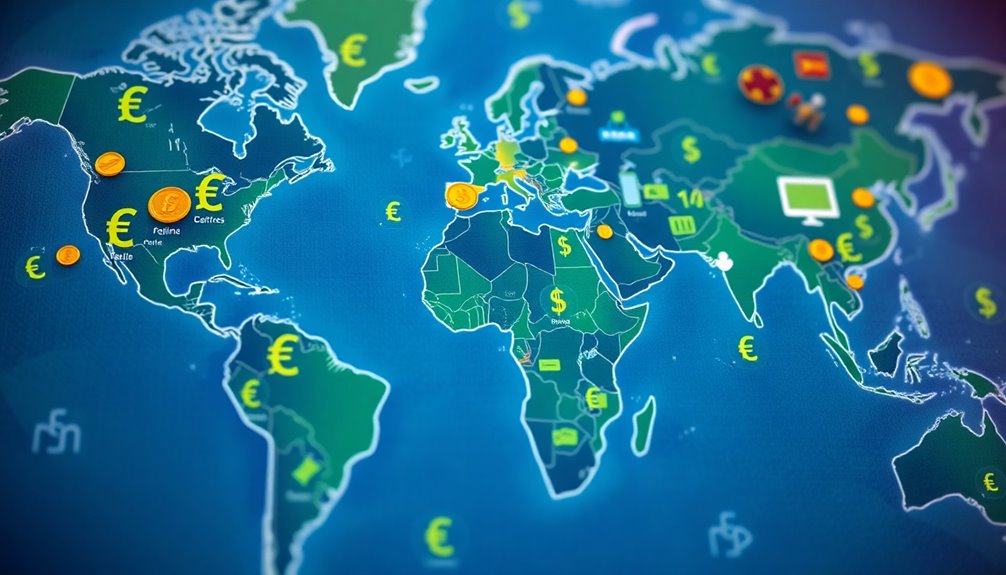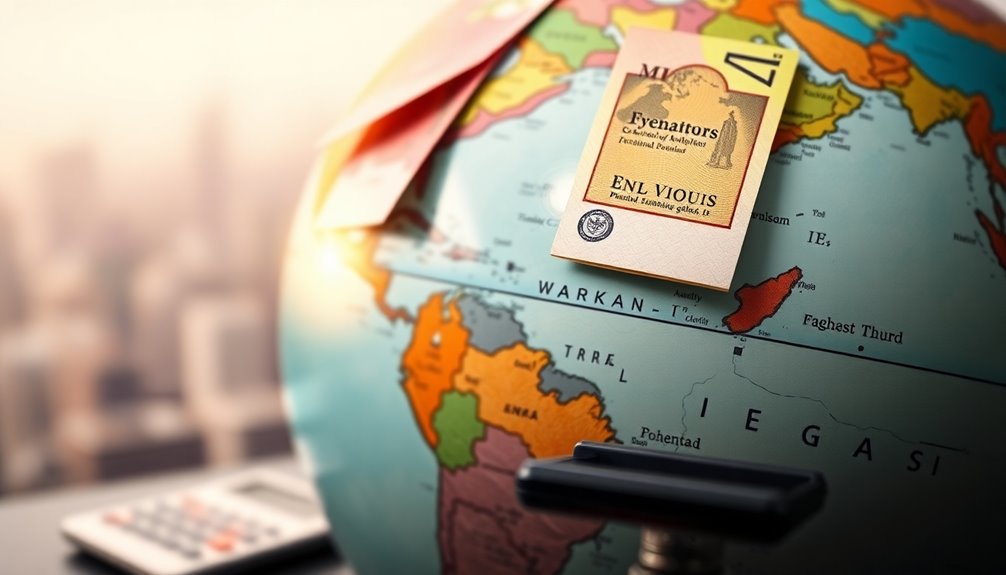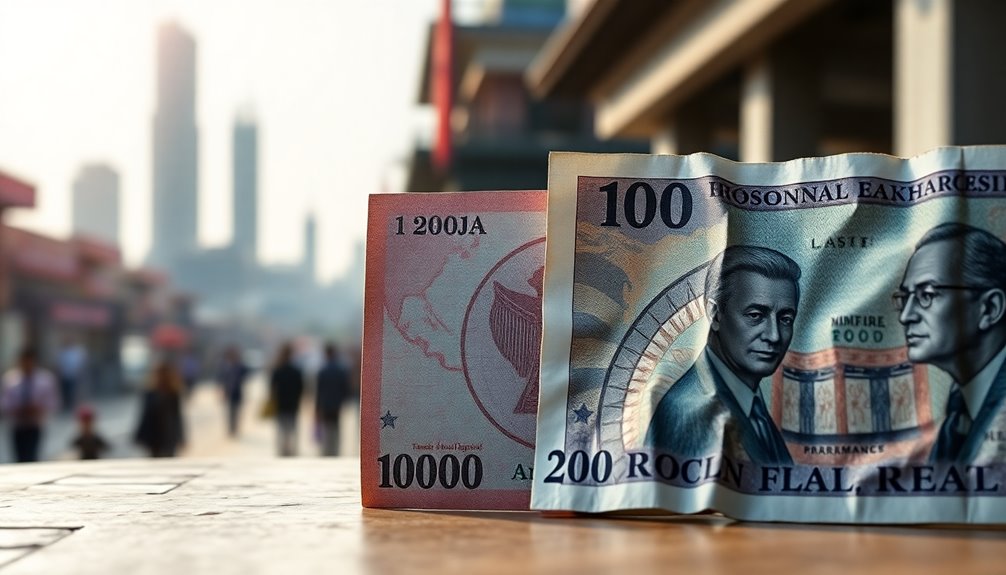Purchasing parity, or Purchasing Power Parity (PPP), compares the cost of a standard basket of goods across different countries. It helps you understand how currency values relate to living costs. By using a formula that divides the cost of the basket in one country by its cost in another, you get insights into economic productivity and purchasing power. While PPP is useful for long-term economic comparisons, limitations arise from local market variations and measurement complexities. If you're curious about how these factors impact global economics, continue exploring this fascinating topic.
Key Takeaways
- Purchasing Power Parity (PPP) compares the costs of a standardized basket of goods across different countries to assess economic productivity.
- The formula for PPP is: Cost of Basket in Country A / Cost of Basket in Country B.
- PPP reflects currency values and cost of living, aiming for identical goods to have the same price in a common currency.
- While PPP is useful for long-term economic comparisons, measurement can be complicated by local consumption patterns and market variations.
- Limitations of PPP include potential inaccuracies due to local price differences and the influence of transportation costs and taxes.
Key Concepts of PPP

Purchasing Power Parity (PPP) is a crucial economic concept that helps you understand currency values by comparing the costs of a standardized basket of goods and services across different countries.
By using the formula PPP = Cost of Basket in Country A / Cost of Basket in Country B, you can determine how much currency is needed to buy the same goods elsewhere. The Big Mac Index is a popular example of this, highlighting price differences of a Big Mac globally to show currency discrepancies.
PPP plays a vital role in comparing GDP per capita across nations, offering a clearer picture of economic productivity and living standards.
However, keep in mind its limitations, including data collection challenges and local market influences.
Understanding Ppp's Core Principles

To grasp the essence of Purchasing Power Parity (PPP), it's essential to recognize how it connects currency values to the cost of living across different countries.
PPP operates on the principle that identical goods should have the same price when expressed in a common currency, reflecting the law of one price. By using a standardized basket of goods and services, you can make direct price level comparisons across economies.
This method helps organizations like the World Bank and the IMF analyze global economic trends and adjust GDP figures for price level differences.
While PPP offers valuable insights for international comparisons, measuring it can get complex due to local consumption patterns and quality variations in goods and services.
Currency Value Adjustment Process

Understanding how PPP connects to currency values leads us to the currency value adjustment process. This process compares the cost of a standard basket of goods in different countries to determine the relative value of their currencies.
You calculate PPP exchange rates using the formula: PPP = Cost of Basket in Country A / Cost of Basket in Country B. This reflects necessary adjustments based on purchasing power.
Inflation rates also play a key role; higher inflation in one country can lead to currency depreciation.
Organizations like the World Bank and IMF gather extensive data, regularly updating PPP figures to account for currency fluctuations and local price variations, ensuring that you have accurate insights into the purchasing power of currencies.
Pros and Cons of PPP

While many economists value Purchasing Power Parity (PPP) for its ability to provide a clearer picture of economic conditions, it comes with both advantages and drawbacks.
On the positive side, PPP accounts for differences in prices across countries, offering a more stable measure of economic well-being over time. This makes it preferable for long-term comparisons and allows for better international GDP assessments.
However, measuring PPP can be complex, leading to inaccuracies due to local consumption patterns or quality variations. Additionally, factors like transportation costs and taxes can skew results, distorting true purchasing power.
Ultimately, while PPP enhances understanding of economic theory, its limitations warrant careful consideration in analysis.
PPP Versus Nominal Exchange Rates

When comparing economic indicators, it's crucial to recognize how Purchasing Power Parity (PPP) differs from nominal exchange rates. PPP offers a more stable measure of currency value by assessing the cost of a standardized basket of goods and services.
In contrast, nominal exchange rates can fluctuate wildly due to market conditions and speculation. For instance, India's GDP per capita is about $1,965 using nominal rates, but it rises to $7,197 with PPP, showcasing the disparity in purchasing power.
The Big Mac Index further illustrates this, showing the Hong Kong dollar's undervaluation. By considering PPP, you gain a clearer picture of living standards, especially in poorer countries, than nominal exchange rates alone might suggest.
Measurement Inaccuracies

Measurement inaccuracies in Purchasing Power Parity (PPP) can significantly affect economic comparisons between countries. These inaccuracies often stem from variations in local price levels and consumption patterns.
When selecting goods for the PPP basket, unique local products that aren't available elsewhere can skew results, complicating accurate comparisons. Additionally, different organizations use varied methodologies and baskets, leading to inconsistencies in reported PPP rates—just look at the differences between the International Comparison Program (ICP) and the Penn World Table.
Non-tradable goods and services, which have unique pricing due to local market conditions, especially in lower-income countries, further contribute to these inaccuracies. Seasonal fluctuations and market changes can also make it tough to maintain accurate measurements over time.
Emerging Market PPP Fluctuations

Inaccuracies in measuring Purchasing Power Parity (PPP) can be particularly pronounced in emerging markets, where rapid economic growth and fluctuating inflation rates create a dynamic environment.
For instance, consider India, where a nominal GDP per capita of $1,965 translates to a PPP-adjusted figure of $7,197. This stark difference highlights the impact of local pricing on purchasing power.
As countries like Brazil and China rise in PPP rankings, the Balassa-Samuelson effect indicates that non-tradable goods' prices increase faster than in developed nations.
Moreover, currency stability in these emerging markets remains volatile, influenced by external factors. Such fluctuations complicate accurate PPP assessments, making it crucial for you to stay informed about these economic changes when evaluating emerging markets.
Use Consistent Basket of Goods

To ensure accurate comparisons in Purchasing Power Parity (PPP), using a consistent basket of goods is essential. This basket represents typical consumption patterns across different countries, including essential items like food, housing, clothing, and transportation.
By standardizing these goods, you can make reliable price comparisons between economies. Organizations like the World Bank and IMF collect prices through surveys to construct accurate PPP calculations.
It's vital to select items that are universally available; localized goods can skew results if included. The International Comparison Program (ICP) provides guidelines that help maintain consistency in the basket of goods, ensuring that your PPP measurements reflect true economic conditions.
This consistency is what helps you understand purchasing power across different nations effectively.
Frequently Asked Questions
What Is Purchasing Power Parity in Simple Terms?
Purchasing power parity (PPP) means comparing how much you can buy with your money in different countries.
Instead of just looking at exchange rates, it focuses on the cost of a specific basket of goods.
For instance, if a sandwich costs $5 in the U.S. and the same costs 20 HKD in Hong Kong, PPP helps you understand that your money's value varies depending on where you are.
It gives a clearer economic picture.
What Is an Example of a PPP?
One example of purchasing power parity (PPP) is the Big Mac Index.
You can compare the price of a Big Mac in different countries to gauge whether currencies are fairly valued.
For instance, if a Big Mac costs $5.58 in the US and HK$20.00 in Hong Kong, it suggests the Hong Kong dollar might be undervalued.
This simple comparison highlights how local prices reflect the broader economic conditions affecting currency values.
How Much Is 1 PPP Dollar?
You'll find that the value of 1 PPP dollar varies greatly depending on where you are.
For instance, in India, it can buy goods worth about 22.5 Indian rupees.
This means that the purchasing power of that dollar is much higher in some countries compared to others.
It's essential to consider local price levels when evaluating how far 1 PPP dollar can stretch in different economies.
What Does PPP Mean?
PPP stands for Purchasing Power Parity. It's an economic concept that helps you compare the value of currencies by looking at how much a standard basket of goods costs in different countries.
Instead of focusing on nominal exchange rates, PPP gives you a clearer picture of what your money can actually buy. By understanding PPP, you can better gauge living standards and economic productivity across various nations.
It's a tool for making sense of global economies.
Conclusion
In summary, understanding purchasing power parity (PPP) is essential for grasping how currency values change relative to a consistent basket of goods. While PPP offers valuable insights into economic comparisons, it also has its limitations, especially in emerging markets where fluctuations can skew results. By recognizing both the advantages and drawbacks of PPP, you can make more informed decisions in your financial and investment strategies. Embracing this knowledge will enhance your understanding of global economics.









